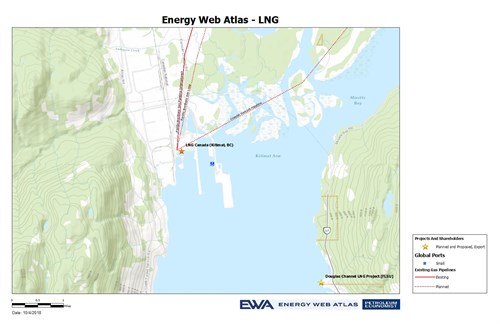Big is back: Canada's mega LNG project gets green light on Asia demand
VANCOUVER/SINGAPORE (Reuters) - The approval on Tuesday of a massive liquefied natural gas export (LNG) terminal in Canada is being touted as the return of the mega-project, ending a lean period where low energy prices and oversupply concerns kept investors from taking big risks.
The C$40 billion ($31 billion) LNG Canada project led by Royal Dutch Shell was given the go-ahead by the Anglo-Dutch giant and its partners, making it the fuel’s first major new project to win approval in recent years.

Construction will start immediately, with first shipments of the super-chilled fuel expected before 2025, aiming to feed surging demand from Asian buyers, primarily China.
“It seems that mega-projects are back,” said Dulles Wang, director, North America gas at Wood Mackenzie, in an email note, adding that LNG Canada is the biggest greenfield project to be approved globally since Russia’s Yamal LNG in 2013.
LNG from the project will reach Asia in about half the time it takes from the U.S. Gulf Coast, LNG Canada said. Global LNG demand is expected to double by 2035, with much of that growth coming from Asia where gas is displacing coal, it said.
At the same time, output from older projects is set to decline in coming years, just as soaring demand from China, India and Southeast Asia is devouring a supply glut previously expected to last for years, fanning fears that an LNG shortage may be looming.
“LNG Canada’s FID would signal the appetite to invest in LNG is back,” said Saul Kavonic, director for Asia Pacific markets and head of energy research at Credit Suisse in Australia.
LNG Canada, to be built in the northern community of Kitimat, British Columbia, also marks the largest private-sector investment project in Canadian history, Prime Minister Justin Trudeau said at a Vancouver news conference.
The announcement provides a much-needed boost for Trudeau’s ruling Liberals, who have struggled with an exodus of global energy firms from Alberta’s oil sands as well as setbacks in building a crude pipeline expansion to Canada’s Pacific Coast.
“We can’t build energy projects like we did in the old days where the environment and the economy were seen as opposing forces,” Trudeau said. “They must go together.”
The project was approved by all its stakeholders - Shell, Malaysia’s Petroliam Nasional Bhd (Petronas) [PETR.UL], PetroChina Co Ltd, Korea Gas Corp (KOGAS) and Japan’s Mitsubishi Corp.
“Getting an LNG project to a final investment decision is like a moon landing,” Maarten Wetselaar, Shell’s integrated gas and new energies director, said in Vancouver. “It is very, very difficult to do, and requires teamwork.”
MEGA-PRICE
The project’s C$40 billion price tag includes the export terminal, the associated pipeline, pre-construction and site work, contingency and upstream carrying costs.
Within that broader number, the cost of building the terminal has been pegged at $14 billion, with the Coastal GasLink pipeline running C$6.2 billion.
Pipeline operator TransCanada Corp said it expects to start construction on the pipeline in early 2019, which will carry natural gas from the Montney gas-producing region of British Columbia and Alberta to the LNG Canada facility.
The project owners will provide their own natural gas supply and will individually market their share of LNG.
LNG Canada’s initial output will be 14 million tonnes per annum (Mtpa) from two trains, or processing units, with the option to add two more trains to expand to 28 Mtpa.
Canada has committed C$275 million to infrastructure and environmental performance measures related to LNG Canada, which will have the lowest carbon intensity of any large LNG facility in the world, Trudeau said.
The project will boost Canada’s oilpatch, which has struggled to attract investment amid pipeline constraints and investor malaise over a recent court decision overturning the approval of the Trans Mountain pipeline expansion.
Natural gas producers such as Encana Corp and Tourmaline Oil Corp stand to gain as Canada’s depressed gas prices rise, Raymond James analysts said. Smaller pipeline companies including Pembina Pipeline Corp will also benefit, said RBC analyst Robert Kwan.
RISING APPETITE
The construction decision comes amid a U.S.-China trade dispute that has led to tariffs being imposed by China on LNG shipments from the United States, threatening U.S. President Donald Trump’s energy dominance plan.
China is the fastest-growing major buyer of LNG and in 2017 overtook South Korea to become the world’s No. 2 importer, behind Japan.
Energy consultancy Wood MacKenzie said it appeared project partners had pushed hard to reach an investment decision, with rival projects progressing in Qatar, Russia, Mozambique and the United States.
“I don’t see it as a case of replacing U.S. cargoes, more about meeting projected demand growth,” said Wood Mackenzie analyst Nicholas Browne.
Reporting by Jessica Jaganathan in Singapore and Julie Gordon in Vancouver; additional reporting by Rod Nickel in Winnipeg, Yuka Obayashi and Osamu Tsukimori in Tokyo, Jane Chung in Seoul and A Ananthalakshmi in Kuala Lumpur and John Benny in Bengaluru; editing by Richard Pullin and Matthew Lewis

- ExxonMobil halts 1-Bft3d blue hydrogen project in Texas
- Aramco and Yokogawa commission multiple autonomous control AI agents at Fadhili gas plant
- Ukraine will resume gas imports via Transbalkan route in November
- Mitsubishi to inject $260 MM into Brunei LNG project
- Freeport LNG (U.S.) on track to take in more natgas on Thursday after unit outage



Comments